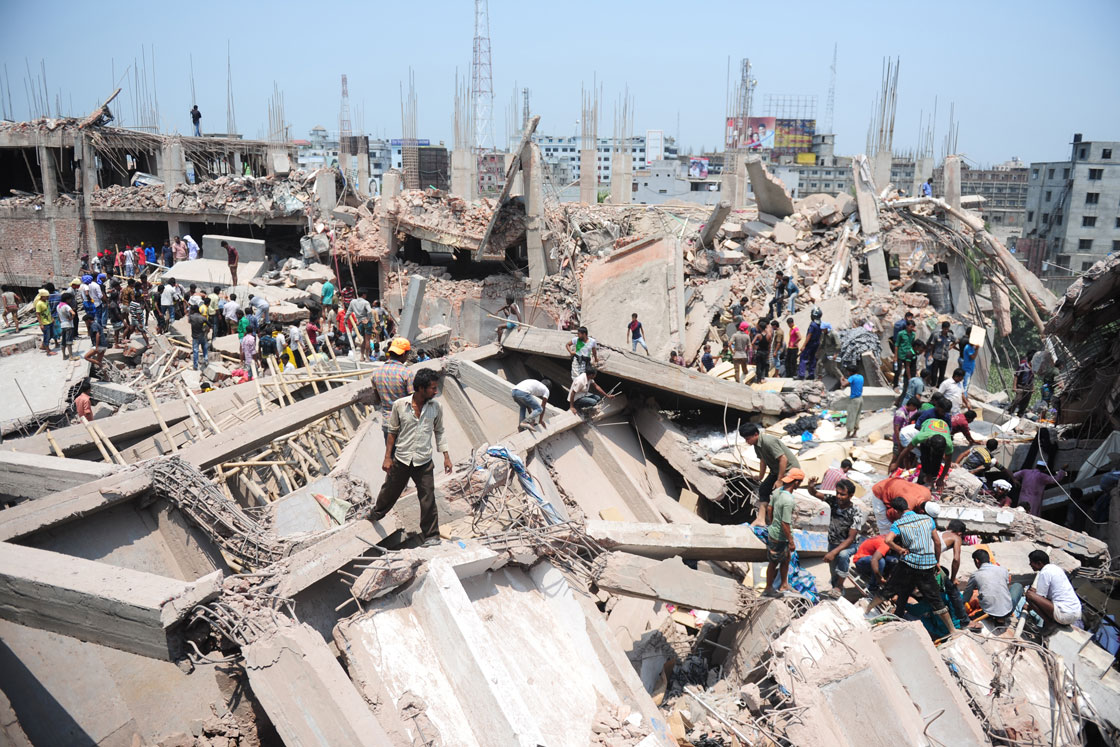SAVAR, Bangladesh – A garment factory building in Bangladesh that collapsed, killing at least 175 people, had been ordered evacuated after deep cracks became visible, but the factories flouted the order and continued working, officials said Thursday.

One day after Wednesday’s collapse, as hundreds of rescuers clawed through the rubble, the cries of trapped survivors could still occasionally be heard, with the screams of a woman pinned between concrete slaps mingling with the wails of distraught relatives waiting for news or collecting bodies. An enormous section of the concrete structure appeared to have splintered like twigs.
The disaster in the Dhaka suburb of Savar came less than five months after a blaze killed 112 people in a garment factory and underscored the unsafe conditions faced by Bangladesh’s garment workers, who produce clothes for global brands worn around the world.
After the cracks were reported Tuesday, managers of a local bank that also had an office in the building, evacuated their workers and suspended their operations. But the garment factories continued working, ignoring the instructions of the local industrial police, said Mostafizur Rahman, a director of the industrial police.
The Bangladesh Garment Manufacturers and Exporters Association had also asked the factories to suspend work starting Wednesday morning, just hours before the building fell.
“After we got the crack reports, we asked them to suspend work until further examination, but they did not pay heed,” said Atiqul Islam, the group’s president.
On Thursday morning the odour of rotting bodies permeated holes cut into the building and rescue workers continued to search for more survivors and victims. Junior minister for Home Affairs, Shamsul Haque, said that by late Thursday morning a total of 2,000 people had been rescued from the wreckage.
Brig. Gen. Mohammed Siddiqul Alam Shikder, who is overseeing army rescue teams, said the death toll had climbed to 175 as of Thursday afternoon.
Dozens of bodies, their faces covered, were laid outside a local school building so relatives could identify them.
The garment manufacturers’ group said the factories in the building employed 3,122 workers but it was not clear how many workers were in the building when it collapsed.
A clearer picture of the rescue operation is likely to be available by afternoon, officials said.
Searchers worked through the night to probe the jumbled mass of concrete with drills or their bare hands, passing water and flashlights to people pinned inside.
“I gave them whistles, water, torchlights. I heard them cry,” said fire official Abul Khayer late Wednesday, as he prepared to work late into the night.
Abdur Rahim, an employee who worked on the fifth floor, said a factory manager gave assurances that the cracks in the building were no cause for concern, so employees went inside.
“After about an hour or so, the building collapsed suddenly,” Rahim said. The next thing he remembered was regaining consciousness outside.
On a visit to the site, Home Minister Muhiuddin Khan Alamgir told reporters the building had violated construction codes and that “the culprits would be punished.”
Abdul Halim, an official with the engineering department in Savar, said the owner was originally allowed to construct a five-storey building but he added another three storeys illegally.
Local police chief Mohammed Asaduzzaman said police and the government’s Capital Development Authority have filed separate cases of negligence against the building owner.
Habibur Rahman, police superintendent of the Dhaka district, identified the owner as Mohammed Sohel Rana, a local leader of ruling Awami League’s youth front. Rahman said police were also looking for the owners of the garment factories.
Among the textile businesses in the building were Phantom Apparels Ltd., Phantom Tac Ltd., New Wave Style Ltd., New Wave Bottoms Ltd. and New Wave Brothers Ltd. According to their website, the New Wave companies make clothing for major brands including U.S. retailers The Children’s Place and Dress Barn, Britain’s Primark, Spain’s Mango and Italy’s Benetton. Benetton’s communications department said in an email to The Associated Press that people involved in the collapse were not Benetton suppliers.
Jane Singer, a spokeswoman for The Children’s Place, said that “while one of the garment factories located in the building complex has produced apparel for The Children’s Place, none of our product was in production at the time of this accident.”
Dress Barn said that to its knowledge, it had not purchased clothing from the factories involved since 2010. Primark, a major British clothing retailer, confirmed that one of the suppliers it uses to produce some of its goods was located on the second floor of the building.
In a statement emailed to The Associated Press, Primark said it was “shocked and deeply saddened by the appalling incident.” It added that it has been working with other retailers to review the country’s approach to factory standards and will now push for this review to include building integrity. Meanwhile, Primark’s ethical trade team is working to collect information, assess which communities the workers come from and provide support “where possible.”
Mango denied reports it was using any of the suppliers in the building. However, in an email statement to the AP, it said that there had been conversations with one of them to produce a batch of test products.
Kevin Gardner, a spokesman at Wal-Mart Stores, Inc., the second-largest clothing producer in Bangladesh, said the company is investigating to see if a factory in the building had been producing for the chain at the time of the collapse.
The collapse was even deadlier than the November factory fire that drew international attention to working conditions in Bangladesh’s $20 billion-a-year textile industry. The country has about 4,000 garment factories and exports clothes to leading Western retailers, and the industry wields vast power in the South Asian nation.
The Tazreen factory in the fire lacked emergency exits, and its owner said only three floors of the eight-storey building were legally built. Surviving employees said gates had been locked and managers had told them to go back to work after the fire alarm went off.



Comments